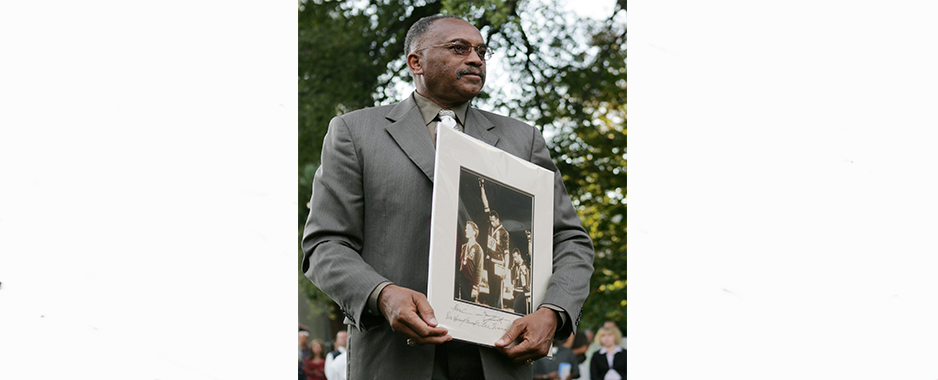By Erin Ratigan/tr news editor

The year was 1968, and Tommie Smith and John Carlos had just won the gold and bronze Olympic medals in 200-meter track.
But Smith and Carlos were not just Olympians, they were about to become symbols of the civil rights movement.
Neither of them knew this until they took to the podium.
As the national anthem rang out across the stadium, Smith and Carlos bowed their heads and raised their fists in protest against discrimination back in the United States. A photographer from The Associated Press captured the moment, and that photo has become one of the most well-known images of the civil rights era.
As Black History Month comes to a close, TR Campus will show the documentary Return to Mexico City Feb. 26. The film highlights Smith and Carlos’ protest and their lives leading up to that moment. Smith will introduce the film and discuss his autobiography Silent Gesture.
Smith said he was inspired to write about his experience after he saw other authors writing about it.
“Everyone else was writing a story about Tommie Smith and what he did,” he said. “So I decided to write a book about the real facts since I was the one they were talking about.”
As he was walking up to the podium, Smith said he was thinking of equality and social change. He said standing up for one’s beliefs often entails “crossing bridges and finding that there’s another bridge to cross.”
“Success, to me, is moving forward for mankind,” he said.
Among the things that came to his mind at the time was the quote from Martin Luther King Jr., who asked Americans to judge others not by the color of their skin but by the content of their character.
Smith and Carlos’ protest came at a tumultuous time in the civil rights movement. By the summer of 1968, both Malcolm X and King had been assassinated, and the fate of the movement seemed uncertain.
When he returned home, Smith found that the public perception of African-Americans was still very negative.
Both Smith and Carlos received death threats.
Still, when he took to the podium, Smith said he believed it was worth risking public backlash to make his beliefs known.
“I do believe that if you have something to say, one should say it and accept the responsibilities,” he said.
Student development associate Dayon Harris organized the showing.
He said it may be difficult for students to relate to the struggles that African-Americans faced during that civil rights era.
Nonetheless, Harris hopes students will leave with a better understanding of the civil rights movement and the importance of Smith’s protest.
“Even though the civil rights movement took place in the ’60s and ’70s, in a sense, it’s still going on,” Harris said.
The beliefs of young people will keep the movement going, Smith said.
“You must believe in something, or you just might fall for anything,” he said.
When it comes to making one’s voice heard, Smith said sacrifices need to be made. Being vulnerable, he said, keeps an open dialogue and can help bring about real change.
“You can tell the truth about yourself, and then you have a responsibility to discuss the pros and cons about your beliefs,” he said. “That’s what a sacrifice is, freedom of speech.”
However, he says it is also important to understand what you are truly fighting for.
“The grass always seems greener on the other side,” he said. “But once you stop over to the other side, that grass you saw might be AstroTurf.”
The showing begins at 11 a.m. and ends with a Q-and-A. Harris said he is excited to tell Smith’s story to students.
“The feeling he had to have at the time,” he said, “I’m getting chills just thinking about it.”

